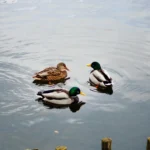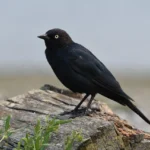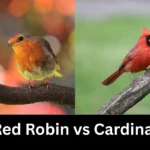Florida is a haven for bird enthusiasts, offering a rich variety of hawks in Florida that thrive in its diverse landscapes. From dense forests to open wetlands, each species contributes uniquely to the state’s ecosystems. This guide highlights the incredible diversity of hawks in Florida, showcasing their appearances, behaviors, and ecological roles. Whether you’re a seasoned birder or a curious observer, Florida’s hawks are sure to captivate your interest.
13 Types of Hawks in Florida
1. Red-tailed Hawk (Buteo jamaicensis)

The Red-tailed Hawk is one of the most widespread hawks in North America. Known for its broad wings and distinctive red tail, this raptor is commonly seen soaring over open fields and forests in Florida.
These birds are adaptable and thrive in various environments, making them one of the most easily spotted hawks in the region. Their powerful build and sharp talons make them skilled hunters, often seen perched high, scanning the ground for prey.
Despite their fierce hunting style, they play a crucial role in maintaining ecological balance by controlling rodent populations.
- Appearance: Brown body with a reddish tail.
- Habitat: Open fields, deserts, and woodlands.
- Diet: Small mammals, birds, and reptiles.

2. Red-shouldered Hawk (Buteo lineatus)

The Red-shouldered Hawk is easily recognized by its reddish shoulders and striking barred chest. These vocal birds are known for their sharp, distinctive calls that resonate through the wetlands and wooded areas they inhabit.
Red-shouldered Hawks are agile hunters, often seen gliding over swamps or perched near rivers, waiting to strike at prey.
Their preference for amphibians and reptiles highlights their vital role in aquatic ecosystems, contributing to the balance of these habitats.
- Appearance: Reddish shoulders, dark bands on wings.
- Habitat: Swamps, river valleys, and mixed woodlands.
- Diet: Frogs, lizards, and small mammals.
3. Cooper’s Hawk (Accipiter cooperii)
The Cooper’s Hawk is a stealthy and agile predator, often found in wooded areas and suburban backyards. Known for its speed and precision, this hawk specializes in hunting small birds, swooping down swiftly to catch its prey. Its adaptability to human-altered landscapes has allowed its population to thrive.
Cooper’s Hawks are often mistaken for Sharp-shinned Hawks due to their similar appearance, but they are larger and have more rounded tails.
- Appearance: Blue-gray back with a reddish-barred chest.
- Habitat: Forests, woodlands, and suburban areas.
- Diet: Small birds and mammals.
4. Sharp-shinned Hawk (Accipiter striatus)

The Sharp-shinned Hawk, the smallest hawk in North America, is an expert hunter of small birds. Its quick and agile flight makes it a formidable predator, often darting through dense foliage to surprise its prey.
This hawk is more commonly seen during migration periods in Florida. While similar to the Cooper’s Hawk, it has a squared-off tail and slightly smaller build, making identification a rewarding challenge for birdwatchers.
- Appearance: Blue-gray back with an orange-striped chest.
- Habitat: Dense forests and edges.
- Diet: Small birds and insects.
5. Broad-winged Hawk (Buteo platypterus)

The Broad-winged Hawk is renowned for its spectacular migrations, forming massive flocks, or “kettles,” that fill the sky. These seasonal movements are a sight to behold, drawing birdwatchers from far and wide.
In Florida, this hawk can be seen during migration seasons as it travels to and from its breeding and wintering grounds. Its diet consists of a variety of prey, reflecting its adaptability and resilience.
- Appearance: Brown above with white underparts and barred chest.
- Habitat: Forests and open woodlands.
- Diet: Small mammals, amphibians, and insects.
6. Northern Harrier (Circus hudsonius)

The Northern Harrier is unique among hawks due to its owl-like facial disk, which enhances its ability to hunt by sound. This bird often glides low over marshes and fields, its distinctive white rump patch easily visible.
Northern Harriers are solitary hunters, preferring to fly alone as they search for small mammals and birds. Their presence is a sign of healthy wetland ecosystems, making them an important indicator species.
- Appearance: Slim body with long wings and a white rump patch.
- Habitat: Marshes, fields, and wetlands.
- Diet: Small mammals and birds.
7. Short-tailed Hawk (Buteo brachyurus)

The Short-tailed Hawk is a rare sight in the United States, with its range primarily in southern Florida. This tropical species is known for its two distinct color morphs, which provide camouflage in different habitats.
It primarily hunts birds, often soaring high in the sky and swooping down on unsuspecting prey. Its limited distribution makes it a prized observation for bird enthusiasts visiting Florida.
- Appearance: Two color morphs: light (white underparts) and dark (blackish body).
- Habitat: Forest edges and open areas.
- Diet: Birds and small mammals.
8. Zone-tailed Hawk (Buteo albonotatus)

The Zone-tailed Hawk’s resemblance to a turkey vulture helps it blend in with scavengers, giving it an advantage while hunting.
This rare visitor to Florida is often mistaken for its lookalike due to its flight style and blackish coloration. When spotted, it’s typically in open landscapes or arid regions, making it a rare treat for birdwatchers.
- Appearance: Blackish with white bands on its tail.
- Habitat: Arid landscapes and open areas.
- Diet: Small mammals, reptiles, and birds.
9. Great Black Hawk (Buteogallus urubitinga)

The Great Black Hawk is an impressive tropical raptor that occasionally appears in Florida. With its striking black plumage and white tail tip, this hawk is a formidable predator of reptiles and amphibians.
While rare, its presence adds to Florida’s biodiversity, particularly in coastal or forested areas. Its powerful build and sharp talons make it an efficient hunter, thriving in its native tropical habitats.
- Appearance: Black body with a white tail tip.
- Habitat: Tropical forests and coastal regions.
- Diet: Reptiles, amphibians, and fish.
10. Ferruginous Hawk (Buteo regalis)

The Ferruginous Hawk is a regal and striking bird, known for its large size and powerful flight. With its rust-colored back and pale underparts, this hawk is adapted to open landscapes where it hunts small mammals.
Though more common in western regions, occasional sightings in Florida make it an exciting find for bird enthusiasts. Its role as a top predator in its habitat is crucial for maintaining ecological balance.
- Appearance: Rusty-red back with pale underparts.
- Habitat: Open grasslands and deserts.
- Diet: Small mammals, including prairie dogs and rabbits.
11. Harris’s Hawk (Parabuteo unicinctus)

The Harris’s Hawk is unique among raptors for its cooperative hunting behavior, often forming small groups to capture prey.
This social strategy sets it apart and increases its success rate. Its striking dark brown plumage, accented by chestnut shoulders and white markings, makes it easily identifiable.
Found in arid regions, the Harris’s Hawk demonstrates remarkable adaptability and intelligence, thriving even in challenging environments.
- Appearance: Dark brown with chestnut shoulders and white markings.
- Habitat: Arid regions and scrublands.
- Diet: Small mammals, birds, and reptiles.
12. Rough-legged Hawk (Buteo lagopus)

The Rough-legged Hawk is a winter visitor to Florida, migrating from its Arctic breeding grounds. Its feathered legs provide insulation in cold climates, a distinctive feature among hawks. Often seen hovering over open fields, it hunts small mammals like voles.
The Rough-legged Hawk’s seasonal presence adds to Florida’s avian diversity, providing birdwatchers with a glimpse of a raptor adapted to extreme conditions.
- Appearance: Light underparts with dark belly bands and feathered legs.
- Habitat: Open fields and tundra.
- Diet: Small mammals and birds.
13. White-tailed Hawk (Geranoaetus albicaudatus)

The White-tailed Hawk is a striking raptor with a distinctive white tail and black band. This bird of prey is rarely seen in Florida, making any sighting noteworthy. It thrives in open grasslands, where it hunts a variety of small animals. Its sharp eyesight and powerful talons make it a skilled predator.
The White-tailed Hawk’s presence in Florida highlights the state’s role as a haven for diverse avian species.
- Appearance: Gray body with a white tail and black band.
- Habitat: Grasslands and open areas.
- Diet: Small mammals, birds, and reptiles.
Conclusion
The hawks of Florida symbolize the state’s ecological richness, offering unforgettable experiences for nature lovers. Observing these raptors in their natural habitats provides a deeper appreciation for the balance they maintain in the environment.

Welcome to World Birds Life, where the wonder of birds takes center stage. My name is Lexi, and I’m passionate about helping you discover the beauty and joy that birds bring into our lives.







